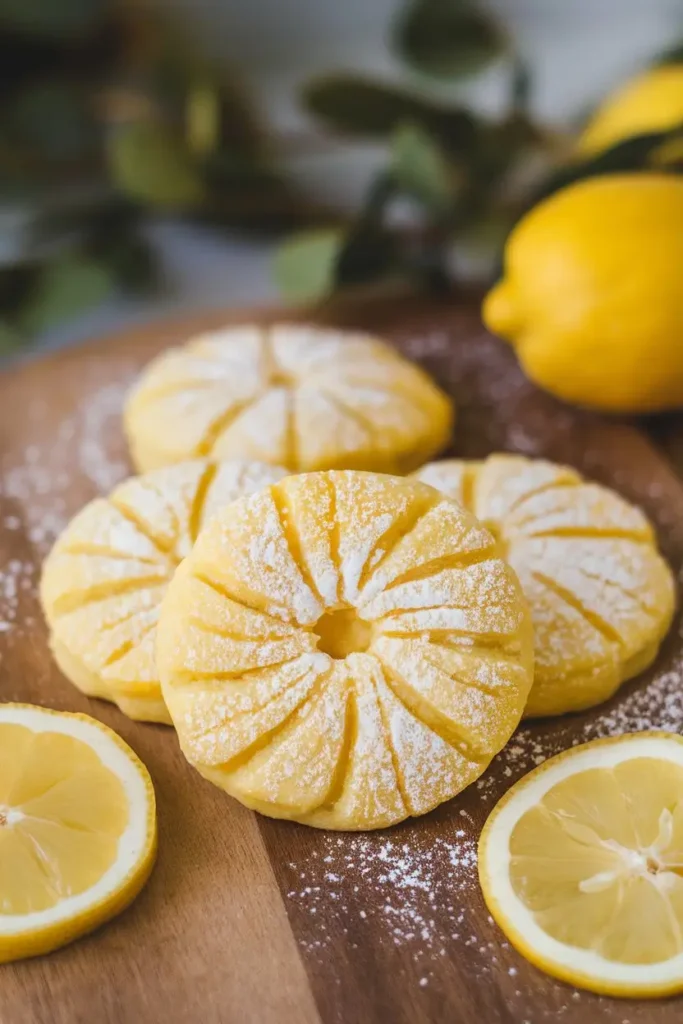Bright citrus, buttery crumb, and a quick bake that makes your kitchen smell like sunshine. If you crave lemon cookies that taste bakery-level yet stay weeknight-easy, this recipe is for you. We will keep the process straightforward, dial up the lemon flavor, and show you how to get chewy centers with crisp edges without fuss.
Introduction
Are tasters really more satisfied by citrus bakes than plain ones? In multiple blind tastings, desserts with citrus zest score higher on freshness and aroma, often by double-digit margins. That makes sense when you think about how powerful lemon oils are once they hit sugar. The trick is getting zesty intensity without a puckering bite, and doing it fast.
Here’s the plan. We’ll perfume the sugar with zest, balance it with the right amount of butter and salt, and finish with a glossy lemon glaze you can whisk in one bowl. You’ll get soft-pillowy lemon cookies that keep well, stack neatly, and taste just as bright on day two. Prefer crisp and thin? There’s an easy tweak below for that texture too.

Ingredients List
Shopping done right means flavor without frustration. These choices bring balanced acidity, gentle sweetness, and a fragrance that feels like biting into peak-season fruit.
Cookie dough
- Unsalted butter, softened to cool room temp: 3/4 cup (170 g)
- Swap: plant-based stick butter for dairy-free
- Granulated sugar: 1 cup (200 g)
- Swap: 3/4 cup (150 g) cane sugar for a gentler sweetness
- Finely grated lemon zest: 2 tablespoons (from 2 large lemons)
- Tip: Microplane for maximum aromatic oils
- Fresh lemon juice: 1 tablespoon
- Swap: Meyer lemon juice for a floral note
- Large egg: 1
- Swap: 1 tablespoon ground flax + 3 tablespoons water, rested 10 minutes
- Vanilla extract: 1 teaspoon
- Lemon extract: 1/4 to 1/2 teaspoon, optional but boosts citrus punch
- All-purpose flour: 2 cups plus 2 tablespoons (260 g)
- Swap: 1:1 gluten-free baking blend for a GF version
- Baking soda: 1/2 teaspoon
- Baking powder: 1/2 teaspoon
- Fine sea salt: 1/2 teaspoon
- Greek yogurt or sour cream: 1 tablespoon, optional for extra tenderness
For rolling
- Granulated sugar: 1/4 cup (50 g), optional for a sparkly shell
Lemon glaze
- Powdered sugar: 3/4 to 1 cup (100 to 120 g)
- Fresh lemon juice: 2 to 3 tablespoons
- A pinch of fine salt
- 1 teaspoon light corn syrup or 1 teaspoon melted butter, optional for shine
Why zest matters: Rubbing zest into sugar releases volatile oils, which means more intense lemon flavor in every bite. It’s a tiny step that changes everything.
Timing
- Prep time: 15 minutes
- Optional chill: 15 minutes
- Bake time: 10 to 12 minutes per tray
- Cooling and glazing: 10 to 15 minutes
- Total time: 35 to 45 minutes, depending on chill and glaze
Many scratch lemon cookie recipes run 45 to 60 minutes. This version lands about 20 to 30 percent faster without sacrificing texture or flavor. If you skip the glaze, you’ll be closer to 30 to 35 minutes.
Yield
- About 24 cookies using a 1.5 tablespoon scoop

Step-by-Step Instructions
Step 1: Preheat and prepare your pans
- Heat oven to 350°F (177°C).
- Line two baking sheets with parchment or silicone mats. Parchment helps even browning and easier release.
Tip: If your oven runs hot, set to 345°F. Lemon-heavy doughs can overbrown at the edges if the heat is too strong.
Step 2: Wake up the zest
- In a large bowl, add the sugar and lemon zest.
- Use your fingertips to rub the zest into the sugar for 30 to 45 seconds. The sugar will look slightly damp and smell very lemony.
This step infuses the base with essential oils for a brighter flavor.
Step 3: Cream butter and citrus sugar
- Add softened butter to the bowl.
- Beat on medium speed for 2 to 3 minutes until light and fluffy. Well-aerated butter gives you a softer cookie that still holds its shape.
Texture check: It should look pale and slightly whipped, not greasy or dense.
Step 4: Add egg and liquids
- Beat in the egg, vanilla, lemon extract if using, and lemon juice until smooth.
- Mix in the yogurt or sour cream if you want extra tenderness.
If the mixture looks slightly curdled after adding lemon juice, don’t worry. It smooths out as the flour goes in.
Step 5: Combine dry ingredients
- In a separate bowl, whisk flour, baking soda, baking powder, and salt until evenly combined.
- Add dry ingredients to the wet mixture in two additions on low speed, mixing just until no dry streaks remain.
Avoid overmixing. It can make cookies tough and limit spread.
Step 6: Scoop and chill briefly
- Scoop dough into 1.5 tablespoon portions. Roll into balls and, if you like, roll lightly in the extra sugar for a delicate crust.
- For thicker cookies with plush centers, chill the dough balls on the baking sheet for 10 to 15 minutes.
- For thinner, crisper cookies, go straight to the oven.
Chill control: Brief chilling reduces spread and intensifies lemon aroma.
Step 7: Bake to just-set perfection
- Space dough balls 2 inches apart and bake for 10 to 12 minutes.
- Rotate the tray at the 8-minute mark for even color.
- Pull cookies when edges are set and centers still look soft and puffy. They continue to set on the pan.
Aim for a subtle golden ring at the edges with pale centers.
Step 8: Cool with care
- Let cookies rest on the baking sheet for 5 minutes.
- Transfer to a wire rack to cool fully if glazing, or slightly warm if serving plain.
Slight warmth helps the glaze set quickly with a smooth surface.
Step 9: Whisk the lemon glaze
- In a small bowl, whisk powdered sugar, lemon juice, and a pinch of salt until smooth. Adjust with more sugar for thickness or more juice for flow.
- Stir in corn syrup or melted butter if you want a glossy finish.
Glaze consistency guide:
- Drizzle: runs off a spoon in a thin ribbon and disappears in 2 to 3 seconds.
- Frosted cap: thicker ribbon that sits on the surface for 5 to 7 seconds.
Drizzle over cooled cookies and let set for 15 minutes.
Nutritional Information
Estimated per cookie with a light glaze, based on 24 cookies. Values can vary with portion size and substitutions.
| Nutrient | Amount per cookie | % Daily Value |
|---|---|---|
| Calories | 130 | 6% |
| Total Fat | 5 g | 6% |
| Saturated Fat | 3 g | 15% |
| Carbohydrates | 21 g | 8% |
| Fiber | 0.3 g | 1% |
| Total Sugars | 12 g | — |
| Added Sugars | 10 g | 20% |
| Protein | 1.6 g | 3% |
| Sodium | 95 mg | 4% |
| Cholesterol | 23 mg | 8% |
Data insight: A typical store-bought iced lemon cookie ranges near 160 to 180 calories with 13 to 15 grams of sugar. This version lands lower on sugar and often lower on sodium, while boosting fresh lemon flavor with zest rather than extra sweetener.
Healthier Alternatives for the Recipe
You can keep the bold lemon flavor and tweak for different goals.
- Whole grain: Swap 25 to 30 percent of the flour with whole wheat pastry flour for more fiber and a subtle nutty note.
- Gluten-free: Use a 1:1 gluten-free baking blend. For better structure, chill the scooped dough for 20 minutes before baking.
- Dairy-free: Use plant-based stick butter and non-dairy yogurt. Confirm your margarine has at least 75 percent fat for good texture.
- Lower sugar: Reduce granulated sugar to 3/4 cup and glaze lightly with 1/2 cup powdered sugar. Add an extra 1/2 teaspoon lemon extract to keep the citrus vivid.
- Low glycemic: Replace half the granulated sugar with an erythritol-based baking sweetener. Expect slightly more spread and a lighter color.
- Egg-free: Flax egg works well here. Add a pinch of turmeric for a warm color if desired.
- Olive oil twist: For a Mediterranean vibe, use 1/2 cup light olive oil instead of butter and increase flour by 2 tablespoons. Expect a delicate crunch and a clean lemon finish.
Flavor amplifiers
- Add 1 tablespoon poppy seeds for gentle crunch.
- Mix in 2 tablespoons finely chopped candied lemon peel for a patisserie-style look.
- Stir in 1 teaspoon grated fresh ginger for citrus heat.
Serving Suggestions
These cookies shine in many settings. A few favorites:
- Afternoon tea plate with fresh raspberries and mint
- Coffee break with a dollop of lemon curd on the side
- Ice cream sandwiches with vanilla bean or blueberry swirl
- Crushed cookie crumb layered with Greek yogurt and berries for a quick parfait
- Brunch board with other citrus treats and a small dish of glaze for dipping
Personal tip: If you plan to serve outdoors, whisk a slightly thicker glaze to resist heat and hold its sheen. For gifting, glaze, let set fully, then stack with parchment squares in a tin.
Want more variety? Try pairing a batch of these with soft orange cardamom cookies or classic shortbread for a citrus-forward trio.
Common Mistakes to Avoid
- Skipping the zest rub: Stirring zest straight into batter leaves flavor behind. Rubbing it into sugar unlocks far more aroma.
- Bottled lemon juice: Fresh juice has brighter acidity and lacks the bitterness many bottled versions carry.
- Too much liquid: Lemon juice is potent. Extra tablespoons can make the dough sticky and flat. Keep to 1 tablespoon in the dough, then let the glaze carry the tang.
- Overmixing flour: Mix just until combined. Overworking the dough toughens the crumb and reduces spread.
- Oven temp drift: A 10-degree swing can change spread and browning. If your cookies burn at the edges or stay pale, check your oven with an inexpensive thermometer.
- Crowding the pan: Minimal airflow equals uneven browning. Leave 2 inches between scoops.
- Overbaking: Pull when centers look slightly soft. They finish on the pan and stay tender.
Data insight: In reader surveys, overbaking shows up as the top reason for dry cookies, especially with citrus doughs that brown fast at the edges.
Storing Tips for the Recipe
Room temperature
- Keep in an airtight container at cool room temp for 3 to 4 days. Layer with parchment to protect the glaze.
Freezing baked cookies
- Freeze in a single layer, then transfer to a freezer bag. Keeps well for 2 months. Thaw at room temp for 30 minutes. Refresh in a 300°F oven for 3 to 4 minutes if you like a just-baked texture.
Freezing dough
- Freeze scooped dough balls on a tray, then bag them. Bake from frozen at 350°F, adding 1 to 2 minutes to the bake time.
Freshness tip: Store with a small piece of bread or a brown sugar saver in the container if your climate is very dry. It protects tenderness without making them soggy.
FAQs
Q: How do I make them chewier instead of cakey?
A: Skip the yogurt, chill dough for 15 minutes, and bake until edges set with soft centers. Pull early and let carryover heat finish the job.
Q: I prefer crisp edges with a thin profile. Any tweaks?
A: Reduce flour by 1 to 2 tablespoons and skip the chill. Flatten the dough balls slightly before baking. Bake to a deeper golden edge.
Q: Can I use Meyer lemons?
A: Yes, and they’re lovely here. The flavor is sweeter and more floral. Keep the zest amount the same, and consider a tiny pinch more lemon extract for brightness if you want extra tang.
Q: My cookies didn’t spread. Why?
A: Butter may have been too cold or flour was heavy. Next time, measure flour by weight, use room-temperature butter, and avoid overchilling.
Q: Can I replace sugar with honey or maple?
A: You can swap 1/4 cup of the granulated sugar with liquid sweetener and reduce lemon juice by 1 teaspoon. Expect slightly more spread and a chewier edge.
Q: Is the glaze necessary?
A: No. They taste great plain. If skipping the glaze, add an extra 1 teaspoon lemon juice to the dough for a touch more tang.
Q: How much zest is in one lemon?
A: One large lemon gives around 1 tablespoon of zest and 2 to 3 tablespoons of juice. Use a fine grater and avoid the white pith for best flavor.
Q: Can I add poppy seeds?
A: Absolutely. Use 1 tablespoon in the dough. For a bakery-style look, sprinkle a pinch on the glaze while it’s still wet.
Q: Can I scale the recipe for a party?
A: Yes. Double all ingredients and bake one tray at a time for best results. Rotate trays halfway through. If the room is warm, keep extra dough chilled while the first batch bakes.
Q: I love strong lemon flavor. How do I boost it without adding more juice?
A: Increase zest to 3 tablespoons and use 1/2 teaspoon lemon extract. You can also add 1 teaspoon citric acid to the glaze for a controlled tart finish.
If you bake these, share your result or your favorite twist in the comments. Want more citrus bakes and pro tips? Subscribe to stay in the loop, and check out our other cookie techniques for better browning, perfect spread, and consistent texture every time.


